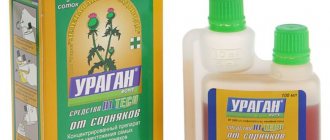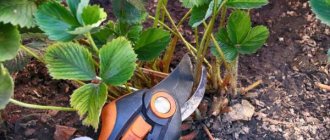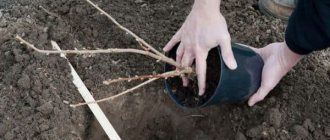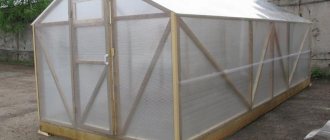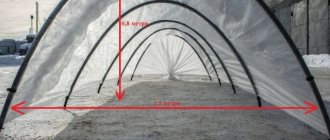One of the most labor-intensive jobs in a summer cottage is weed control. Parasitic plants take away nutrients from garden crops. As a result, the latter reduce productivity, get sick more often, and in some cases may even die. To control weeds, both mechanical methods (weeding) and chemical methods (herbicides) are used. Both of these technologies are quite effective, but have a number of disadvantages.
Weeding is a time-consuming procedure, and chemicals can accumulate in plant tissues, which makes their fruits hazardous to health. Meanwhile, there is a technique that allows you to reduce labor costs when growing garden crops and at the same time eliminate the possibility of the negative impact of herbicides. Modern enterprises have begun to produce special black weed control film. This material is relatively inexpensive and can save a summer resident a lot of time and effort.
Does black film help with weeds?
Using this material is quite simple. In spring it spreads out on the ground. Next, holes are made in it for planting plants. One of the features of black film is that it does not transmit sunlight at all. As a result, weeds that do not receive ultraviolet light stop developing.
In Europe, film and roofing felt have been used for weed control for a long time. Moreover, this is done not only by private individuals, but also by large farms. In this part of the world, black film is considered to be very effective against weeds. Many domestic gardeners also speak well of this method. But some summer residents are still skeptical about this technique. So, does black film help control weeds? Let's look at this in more detail.
Making a path
Agrofibre will help get rid of weeds not only in the garden bed, but also on the paths of the plot or in the garden. First, let's prepare all the tools necessary for this. Then, you should purchase any of the inexpensive non-woven materials, but preferably it should be black. It allows air and water to pass through well, but does not allow light to pass through, so after finishing work on your paths you will not have to see any weeds or puddles. Now let's start arranging the tracks. To do this, we prepare a substrate that serves as mulch for the paths: crushed stone, expanded clay, gravel, stones.
Now we remove the top layer of soil from the paths. It is necessary to ensure that the surface of the earth is strictly horizontal.
Then, carefully compact the path. If necessary, we remove excess soil, then the path will turn out smooth and neat.
Now we spread the prepared black film along the path. The joints must be overlapped so that seeds cannot penetrate into the cracks. If your greenhouse, where strawberries and other crops grow, has beds instead of boxes, then you need to leave some material for allowances on the edges. This is done so that crushed stone or other mulching substrate does not mix with the ground.
After this, we pour crushed stone or any other substrate that you have prepared for mulching onto the path so that it is level with the ground, or slightly lower. We level the crushed stone and remove excess material sticking out from under the substrate.
That's it, the work is finished, the path will look clean and tidy for a very long time.
What processes occur under the film?
Weed control with black film can actually be quite successful. The edges of this material lying on the ground are usually covered with soil. As a result, a special microclimate is created in a garden bed mulched in this way. The soil under the film warms up very quickly. Therefore, weeds accelerate their development at the first stage. However, when germinating, the grass rests against a film heated by the sun. The result is the death of the surface part of the plant. After some time, the roots of the weed also rot.
Why is covering material so good?
The first thing that is usually planted on mulching material for cover and because of which people decide to purchase it is strawberries. After all, it is much easier to grow it this way; you don’t have to replant it for 3 whole years and there are far fewer weeds. And positive reviews from grateful customers are especially encouraging - it’s time to put an end to “garden slavery.”
Interestingly, the soil under the film often remains looser than under the non-woven material. The fact is that in the latter, even the berry absorbs more moisture during the rainy season than from the ground. And strawberries on such a surface ripen much faster - much faster than ordinary ones. The berries are clean, not on the ground, dry and pleasing with a beautiful presentation. And the yield in the end is also higher.
Many people are surprised: how then to loosen the soil? The fact of the matter is that you only need to loosen “bare” soil, which is something you won’t find in nature. After all, this one gets weathered and becomes crusty, while nothing like that happens under the shelter - it perfectly retains moisture.
Where can I use it?
The use of black weed film (photos of such beds are presented on the page) is allowed both in open ground and in greenhouses. Very often this material is used for the development of virgin lands. In this case, the film is laid directly on top of the weeds and left there for a long time (1-2 months). As a result, the grass rots along with the root system. The soil under the film becomes loose and easy to work. Subsequently, even in the absence of film, weeds in the area do not grow as actively.
Planning a vegetable garden
If you already have a summer house or a plot of land near your house, you have probably already encountered a situation of an overabundance of fruits, vegetables and berries. When the harvest has to be distributed to relatives, neighbors, and colleagues. But in order to grow it, a lot of effort had to be made. To avoid such a situation, it is necessary to plan the harvest. It’s clear that you won’t get great accuracy, but results close to the planned ones are possible.
A smart vegetable garden is also a decoration of the site
We count the area of the beds
The first thing to do is sit down and think about what and how much you want to grow. The specific quantity is in kilograms. How much do you need to “eat” and “close”. Write a list of plants (in a column) and the desired harvest.
Having decided on the list of plants that you want to grow in your home, we sit down and look at the average yield that can be achieved when grown in smart beds. It is given in the table. Since you are still an inexperienced “lazy gardener”, reduce it by half. We put numbers next to each of the plants. It must be recorded in kilograms per square meter of area.
Approximate yield of vegetables and herbs when grown in smart beds
Now it’s easy to calculate how much area you need to allocate for each type of plant: divide the desired yield in kilograms by the average yield for each type of plant. We get the square footage for vegetables, berries, herbs, etc. If we add up all these areas, we will find out how many beds you need in total. These are the beds that should be placed on your site.
You're probably surprised by how little space you need for garden beds. And it's really not enough. Many times less than what we are used to! You will have very little land to cultivate. The freed up space can be used for flower beds, rockeries, fountains and other decorations.
Where to place
When planning smart beds, you need to take into account the degree of illumination. Almost all the plants you need prefer sunny places. In partial shade you can grow rhubarb, sorrel, and onions (including feathers). Perhaps that's all. There are no garden plants that grow well in shaded areas. Or rather, they will grow, but the yield will decrease by 3-4 times. Shaded areas should be set aside as a recreation area or a flower bed with shade-loving plants should be placed there.
Layout of beds: only in the sun
Another principle for placing beds: the more care (read watering) a crop requires, the closer to the entrance to the house it should be located:
Beds with capricious plants are located as close to the house as possible
Why arrange the plants this way? Because at the beginning of the watering/weeding work, gardeners are full of enthusiasm and the plants receive more water, weeds are removed more thoroughly. Gradually, the fervor subsides, less and less water is available per square area, and processing becomes less thorough. And with the approach proposed above, the amount of water will be “just right” and everything will be fine with soil cultivation.
Orientation to cardinal directions and precise location determination
If you want to get a harvest from the entire area of the lazy bed, the location is north-south. Strictly. This is the only way the entire area will bear fruit. Also place trellises for climbing vegetables. Although, they can be planted along the southern and eastern walls of buildings.
For a smart garden to also be beautiful, you need to think about where to place the beds. To do this, take a scale plan of the site indicating the direction to north/south. On it we draw all the buildings and main paths, water supply (we pay special attention to the position of the taps), trees and shrubs. On the plan we immediately outline the shadow zones - we will not place vegetables here, this is a place for flowers, gazebos, fountains.
One of the beds for a smart vegetable garden: a high bed
We cut out the beds from paper (on the same scale as the site plan). Moreover, we make them in the shape that we plan: rectangle, square, circle, triangle, etc. The shape is selected based on the area planned for the crop. And it doesn’t have to be a boring rectangle. Since there will be enough free space (you remember that you need much less beds), rationalism fades into the background, and the main emphasis is on aesthetics. After all, few people work in their dachas “so that they have something to eat”; mostly it’s also a pleasure. And what could be more pleasant than the beauty of a cultivated plot?
So, we sign each piece of paper indicating a smart bed - we put the name of the crop or crops (you can grow two, three or more on one bed). Now we are looking for a place for each, taking into account the rules described above. Along the way, you can change the shape of smart beds: for the sake of beauty or convenience. When you have found the places, trace the contours and transfer the inscriptions. All that remains is to implement our plans.
Benefits of use
Thus, weed control with black film can reduce labor costs in the garden, greenhouse or nursery. Compared to conventional methods, this mulching technique also has the following advantages:
- early warming of the soil in spring;
- better heat retention by soil in winter;
- reduction of irrigation costs;
- no need for loosening;
- acceleration of plant development.
Since the black film is an airtight material, the soil underneath it warms up very quickly. Therefore, plants in the spring with such mulch begin to develop at an accelerated pace. This material also reduces the risk of crop death during recurrent frosts.
The film does not allow moisture to pass through. Therefore, you can water plants in beds covered with this material less often. As moisture evaporates, in this case it condenses on the film and flows down again. This material is more convenient to use than many other types of mulch. All that is needed in this case is to spread the film over the area once.
Also, the advantages of using this material include the fact that, unlike organic matter, mold almost never forms under it. The air entering under the film through the holes made is quite enough for this.
Description of material
Made from high-density polyethylene stabilized with carbon black, black greenhouse film differs from transparent film not only in color, but also in its properties and, accordingly, in its scope. Like regular film, this film is produced in sleeves wound into rolls ranging from one to three meters wide. After cutting one side and unfolding, the material becomes twice as wide.
Advice. The polymer is easily cut along the fold with a knife or open scissors. But if you need to unroll a very long sleeve, do not rush to unwind the roll - just cut off one edge with a hacksaw or a fine-toothed circular saw.
To satisfy any consumer needs, the film is produced in different thicknesses: minimum - 40 microns, maximum - 200 microns. But even the thinnest one practically does not let sunlight through. It is this property that is actively used in agriculture and in particular in industrial and home greenhouses.
Mulching film with perforation
The price of black film compared to other varieties of this material is much lower, and the benefits from its use are very noticeable, so its use can be considered profitable and practical.
Disadvantages of use
Of course, such material has not only advantages. Most gardeners consider the main disadvantage of using black weed film to be the inability to replenish the soil in the beds. Organic mulch is usually dug up in the fall, which increases the humus content in the soil. The film does not have this advantage.
In addition, spreading it on the ground is quite a troublesome task. In addition, this material is also quite easily damaged. The film on the beds has to be replaced after just a few years. This procedure is also quite labor-intensive. This is especially true for perennial plantings. Indeed, in this case, when disposing of the film, you need to try not to damage the plants.
In virgin lands, this material is also sometimes impractical to use to remove weeds. Usually only fairly soft grass rots under the film. Tough weeds often cannot be eradicated in this way. After all, sometimes for such grass even, for example, asphalt is not an obstacle.
Selecting seeds and preparing a site for a nursery
To grow seedlings under film cover, it is recommended to use zoned early and mid-season varieties of garden crops. As for tomatoes, the varieties Far North, Sanka, Siberian early ripening, and Ogorodnik are suitable here.
The area for the film nursery should be prepared in advance: dig up in the fall, add organic matter and mineral fertilizers. In spring, dig a shallow trench (up to 20 cm) along the width of the film.
Experienced gardeners recommend placing a layer of insulation made of straw or sawdust at the bottom of the trench - this will protect the seedlings from the cold and not yet warmed up ground. Apply a layer of soil that was dug up on top of the sawdust.
What to look for when purchasing material
Protection against weeds with black film will be effective, of course, only if it is chosen correctly. Many companies produce this covering material today. At the same time, the black mulching film itself may vary in technical characteristics.
When choosing this material, you should pay attention first of all to its thickness. A thin film is only suitable for warming the soil in spring. Actually, for mulching, you should take material that is stronger, more durable and thicker. Perennial crops, for example, strawberries, are usually protected from weeds with a 100-micron black film. It is not advisable to use thicker material even in this case. A very thick film is expensive and is mainly suitable only for construction work.
If annual crops are to be mulched, fairly thin material can be used. In this case, the 80 micron option is most often used.
Why do you need mulching film?
The protective layer created by mulching helps protect crops from pests and weeds and improves soil quality. Polyethylene began to be used for mulching recently; before that, vegetable growers covered the soil in their gardens with weeds, ash and straw.
The use of new synthetic covering material for mulching makes it possible to:
- create a protective layer that will prevent vegetables and berries from coming into contact with the ground;
- minimize the difference between day and night temperatures on the soil surface;
- reduce the consumption of fertilizers spent on fertilizing;
- reduce the amount of moisture evaporated from the soil and save on water;
- reduce labor costs;
- get an environmentally friendly product;
- increase productivity;
- improve soil condition;
- stop the growth of weeds.
The crop, grown using advanced agricultural techniques, has an attractive appearance and is suitable for sale.
How to lay black weed film
Technologically, laying this material is a simple procedure. However, there are some rules to follow when performing this operation. You can lay the film on the ground only after the soil has warmed up well enough in the spring. The area must first be cleared of debris and dirt. Most attention should be paid to sharp objects that can damage the material - dry branches, glass, stones. If there are already weeds on the site, it is advisable to remove them.
The film should be spread in such a way that it fits as tightly as possible to the soil surface. In those places where air “bubbles” remain, weeds may subsequently begin to develop. Of course, they will not grow too actively, and their color will not be green, but white - but still.
After the material is laid out on the ground, its edges should be pressed down with some kind of weight. This could be, for example, stones, bricks, or even just soil. Next, cross-shaped or slot-shaped holes are made in the film for planting plants. Round or square slits should not be made. Experienced summer residents have noticed that with this method of cutting, the plants subsequently develop worse. The distance between the holes is selected depending on the type of garden crop. For example, for strawberries this figure will be 30-35 cm.
As soon as shoots appear on the bed covered with film, several semicircular holes should be made in the material on the south side. Without normal air exchange in the soil, plants are known to develop worse. In addition, in this case, acidification of the soil may occur. The holes will provide air access under the film. In addition, if they are present, the soil under such covering material will not overheat too much.
Folk ways to eradicate grass
How to close the paths between the beds to prevent grass from growing
Among summer residents and gardeners, improvised means of controlling weeds are very popular. For example, boiling water, burning with fire using a blowtorch, and watering weeds with a solution of water and vodka are widely used. To destroy grass between paving slabs, spray with a mixture of vinegar (200 g), salt (20 g) and water (600 g).
Grass tends to grow much faster than cultivated plants. Closed beds will look quite aesthetically pleasing. And flower beds covered with tree bark or walnut husks will add zest to the landscape design of the site. You can cover the soil to prevent grass from growing using almost any available means. The main thing is that they do not allow light to pass through, but allow the soil to breathe and maintain water permeability.
4 4 votes
Article rating
Reviews from summer residents
About 20 years ago in Russia there was a real boom in the use of black weed film as mulch. However, subsequently many gardeners abandoned this method. This was explained primarily by the fragility and not very good quality of the film produced at that time. Today, many gardeners are returning to film covering technology. Summer residents consider the main advantage of this technique, of course, to be the opportunity to refuse weeding. Also, many gardeners attribute the advantages of black film to the fact that when using such material, fruits do not get dirty on the ground.
This mulch, according to most gardeners, is best suited for strawberries and cucumbers. Black film also works well against weeds, reviews of which on the Internet are actually mostly positive, when used for tomatoes and zucchini.
The disadvantages of this covering material are considered by summer residents to be largely the fact that when using it it is difficult to maintain crop rotation. After all, the slits in the film are made at a certain distance from each other. And what is good for one culture may not be suitable for another. It is for this reason that the film usually has to be changed at least once every three years.
How to cover the soil to stop grass growth
What to do to prevent grass from growing
Weeds significantly complicate the cultivation of fruits and vegetables. It is recommended to cover the ground with covering material in order to grow crops.
Main methods:
- Use an opaque material to prevent grass from growing. Cardboard, black film, and roofing felt are suitable for covering. You can also lay boards, cover them with agrofibre or crushed stone.
- Cover with 5-10 cm of organic mulch. Mown green plants, sawdust, nut husks, and tree bark will perfectly cover the soil and prevent the growth of weeds.
How to store
If black weed control film is used on perennial crops, it is usually left directly on the beds over the winter. If the material was used as mulch, for example, for cucumbers or zucchini, it is, of course, better to remove it in the fall. Manufacturers and experienced gardeners recommend storing the film wound on a round stick. The material should first be wiped with a cloth. The resulting roll should be kept in a dark, dry room in winter at an air temperature of 10 °C. This storage method can significantly extend the service life of the material.
Irrigation system
A significant part of gardening work is watering the plants. If you use lazy beds, you will have to water much less often. But even in this case, it is better to route the pipes around the area correctly. You already have a plan for the location of the beds in your garden. Now add flower beds, bushes and trees. Get a plan for the placement of plants that need to be watered. Now you should think about how to lay water pipes in the garden so that any “irrigation object” is no more than 2-3 meters away. If you do this, then you will have to pull a small hose to each bed, which is much simpler.
Homemade drip irrigation system made of polymer pipes, water source - barrel
It’s even better if a hose for drip irrigation is installed in the smart garden bed. This will reduce water consumption and increase yield. Yes, at the same time. A drip irrigation hose is a polyethylene tube with small holes through which water drips drop by drop. When planting, plants are planted next to the holes. As a result, water is supplied to the root, the plant receives a sufficient amount of moisture, and the spaces between plants remain only slightly moist (due to the redistribution of moisture in the soil).
When using drip irrigation, you will have very little work. You open the tap, wait a certain period of time, close the tap. All. Hoses for drip irrigation are available for connection to a water supply (sold by the meter), and are available in the form of kits with a small pump that will pump water from the container. The price range for hoses for drip irrigation is significant - prices differ significantly. No matter how limited your finances are, don't buy the cheapest hoses - they won't last more than one season. It’s better to pay a little more for a quality product and use it for several years. When choosing kits for drip irrigation, you must also consider the area to be irrigated. But, most likely, it will suit you, since lazy beds are rarely large. Read more about drip irrigation kits and manufacturers here.
Some tricks
The technology is called smart gardening for a reason. You can test different approaches, new products, and the experience of “colleagues.” There are several tricks that come with use. We have already talked about one - about covering material. It really makes maintenance a lot easier and there is no need for mulch. There are other interesting ideas:
This harvest makes my heart happy
Surely there are still tricks in processing a smart vegetable garden. If we find out about them, we will definitely update the article.
Source
Treatment against pests and diseases
When using covering material for growing cucumbers, fruiting begins much earlier than when grown in open ground without film. The number of maintenance activities required is also reduced. Weeding is done less frequently as fewer weeds spread. It is important to monitor the condition of the soil substrate. In conditions of high humidity, as well as when plant debris begins to rapidly decompose, there is a high probability of the development of fungal diseases.
To protect yourself from this trouble, at the beginning of March it is recommended to treat the film cover with this solution - pour 1 tbsp onto a bucket of water. l. "Formalin" and "Karbofos". Also preventative is treatment with a solution of wood ash. If there are diseases, you should immediately remove the bush and dispose of it.
Diseases
Feeding cucumbers with boric acid and iodine is a reliable protection against the development of diseases such as powdery mildew and root rot. Mix 35 drops of iodine with 2 g of potassium permanganate and boric acid. Pour the solution into a bucket of warm water. Instead of iodine, you can take brilliant green.
With improper care or in the absence of the necessary growing conditions, you may encounter the development of the following diseases:
- Fusarium. The scourges begin to wither and die. Most often, the development of fusarium occurs with the beginning of the flowering period, during prolonged cold spells. To get rid of the disease, you need to treat it with the drugs “Fundazol” or “Fitosporin”.
- Anthracnose. It appears as brownish spots on the surface of leaf blades. The reason is high air humidity. Treatment is carried out using Bordeaux mixture, Burgundy liquid or any other fungicidal preparations.
- Powdery mildew. You can get rid of it with the help of antifungal agents.
- Downy mildew. To get rid of it, fungicidal drugs are used.
- Bacteriosis. “Bordeaux mixture” or “Fitosporin” is effective against it.
- Root or gray rot. You can get rid of it with the help of “Previcur” or “Trichodermin”.
Pests
Most often, vegetable growers encounter the following pests:
- Slugs. They are collected by hand. You can set traps.
- Aphid. Treatment is carried out with a concentrated solution of laundry soap or Fitoverm.
- Whitefly. They use glue traps and spray them with “Bud” or “Karbofos”.
- Spider mite. The bushes are treated with Fitoverm.
To reap a plentiful and high-quality harvest of cucumbers, it is recommended to plant them correctly and follow all recommendations for caring for the vegetable crop.





